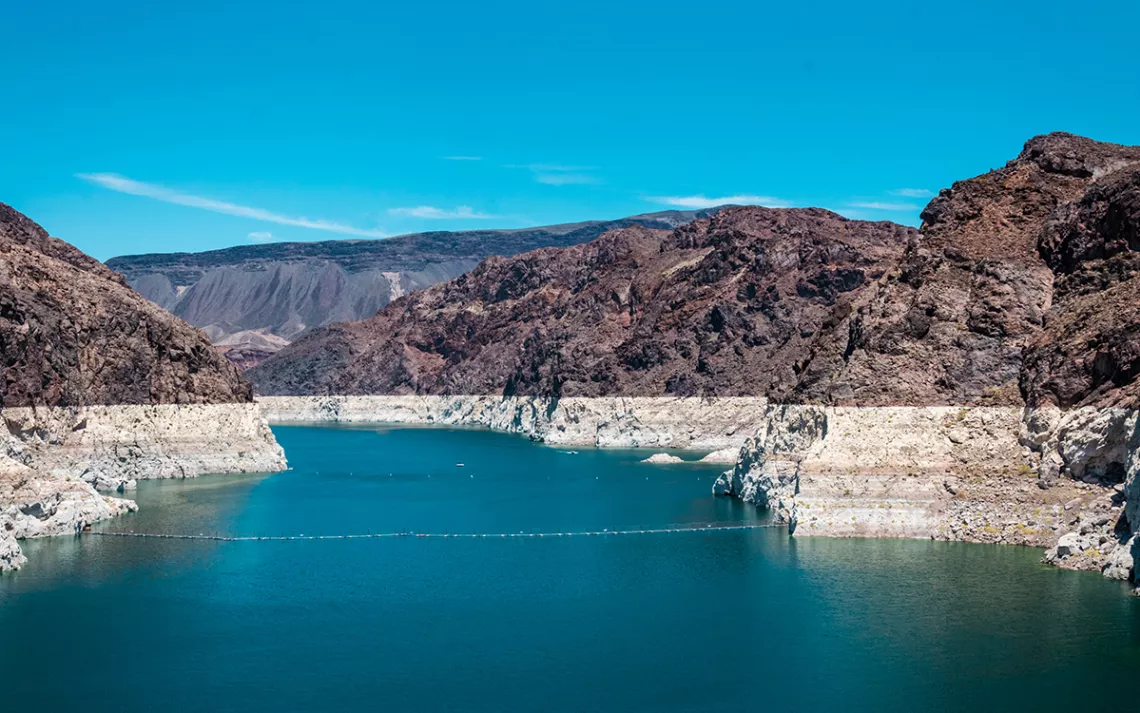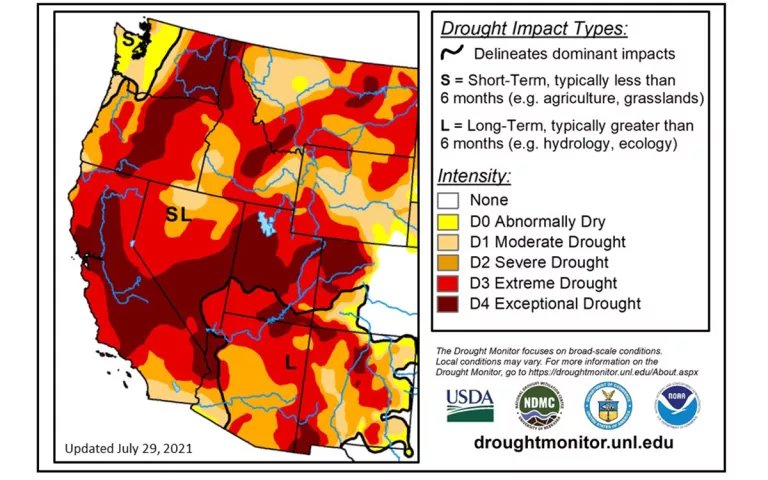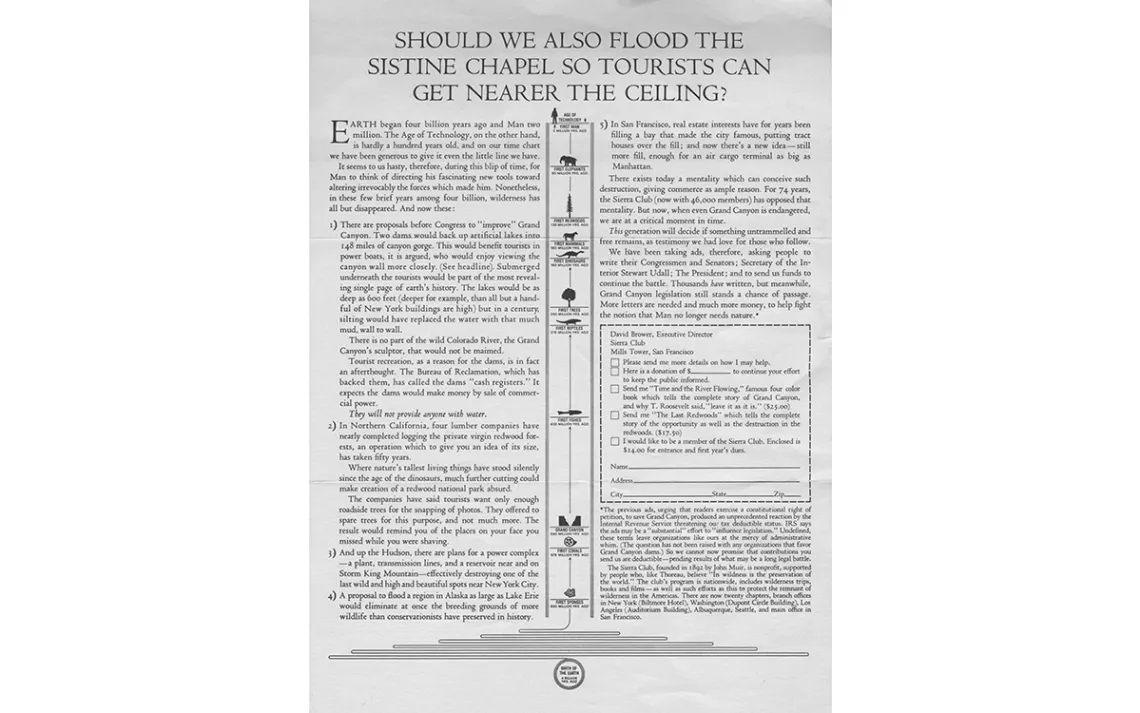The Great Western Drought, Explained
Outdated water policies and the threat of climate change are driving the need for new solutions

Photo by Konoplytska/iStock
Yes, another severe drought is sweeping across the western United States. California is now two years into a deep drought after suffering from its worst drought in 1,200 years between 2012 and 2016. There are many ways to define drought, but the most straightforward way to think about it is when there is a serious mismatch between the amount of water nature provides and the amount of water humans want: either too little supply or too much demand.
It’s time to acknowledge two new realities. First, water policymakers in the western United States made serious mistakes from the beginning when they built our current water infrastructure, laws, and institutions, focused solely on taking water out of the environment. Unlike Indigenous water knowledge—which often views the relationship between water, humans, and ecosystems more holistically—the water frameworks that drove current water management decisions in the West largely turned a blind eye to the consequences for nature.
Second, something new is happening, worsening our already difficult water problems. Human-caused climate change is now influencing the extremes of weather and beginning to disrupt society in new and damaging ways.
We must find a new path and new solutions that acknowledge these realities.
Drought and water scarcity grip the West
The Colorado River basin, shared by seven US states and Mexico, is in the midst of a two-decades-long stretch of below-normal flows. Reservoirs are at historically low levels, and fish and farms are already suffering. The mountain snows are gone, months early. Soils are parched and forests are dry as tinder. Record heat waves have struck the region, from Canada to Mexico, killing people, trees, and wildlife. And fires, plaguing the US West for the past several years, have started earlier than normal and are extending even later into the year.
Some people are starting to call it a megadrought, a period of extended dryness the likes of which may have contributed to the collapse of the Mayan civilization and the out-migration of the Ancestral Puebloans around a thousand years ago. As of August 2021, 99 percent of the United States west of the Rockies is in drought, as severe a measurement as any in the historical record.
The US West has always experienced droughts. The earliest white explorers and settlers brought with them false assumptions about the abundance of water, expectations about the nature of the environment, and belief that they could exercise dominion over the land, water, and Indigenous peoples in the region—mistaken ideas learned from their experiences in Europe and the eastern states. We are all still living with the consequences of those cultural myths and their underlying assumptions, having spent more than a century trying to pretend differently, trying to reshape and mold the West into the image of a wetter, more forgiving landscape.
The growing populations and economies of the western US have increased the risks of drought by increasing demand over the past century—although recent trends in water use indicate some promising signs. In 1900, the total population of the 16 states and territories west of the 100th meridian—the legendary boundary between the humid East and arid West—was 11 million. By the year 2000, it was 91 million. Just two decades later, in 2020, it was 116 million, all sharing the same fixed water resources. In 2020, more than 25 million acres of land in the West were under irrigation, putting even more pressure on the region’s limited water. It should be no surprise that our current water institutions, laws, and infrastructure are not up to the challenges of the 21st century.
Even without climate change, tensions over allocations and control of water are growing. We see it here in the United States, and we see it around the world. As the entire US West was plumbed to meet the needs of thirsty irrigators and growing cities, we also began to learn about the limitations of the supply-side approach. Rivers started to run dry. Wetlands and natural ecosystems disappeared, causing massive die-offs of hundreds of millions of migrating birds. Fish populations plummeted, and ecologically, commercially, and culturally valuable species were driven to the brink of extinction or lost entirely.
In addition to the failure to meet the basic water needs of ecosystems, global society is also failing to meet the basic water needs of human populations. Worldwide, more than 2.2 billion people—over a quarter of the global population—lack access to safely managed drinking water, with significant implications for human rights, human health, and gender equality. Many find it hard to believe that even in the United States, millions still lack safe-water access. This stark reality is often disproportionately experienced domestically by low-income households, Indigenous peoples and other people of color, and marginalized communities. The Pacific Institute and US Water Alliance have documented that at least 140,000 people in California alone live with incomplete plumbing, and tens of millions more nationwide have unsafe drinking water or cannot afford basic water service. The severe drought only exacerbates these problems.
We can no longer ignore that climate change is turning up the dial on these problems.

Climate change requires a new paradigm
The evidence that we are now fundamentally altering the climate is unambiguous and undeniable. The consequences for the western United States include more extremes of both wet and dry periods, more rapid loss of the mountain snowpack, changes in the timing and volume of river flows, higher water temperatures in sensitive riverine ecosystems, upward pressure on water demand, and growing and intensifying heat waves and forest fires.
Don’t call it the new “normal.” There’s nothing normal about it. We’ve flipped from a variable but stable set of conditions to a constantly evolving, changing, and–until we get greenhouse gas emissions under control—worsening set of conditions.
It’s time for a fundamental change in the way we think about and manage our scarce water resources. In the 20th century, the focus was on enhancing supply by building massive dams and reservoirs to capture water in wet periods to use in dry ones and long aqueducts to move water from areas of abundance to areas of scarcity. That approach brought benefits to the booming West but also led to unanticipated costs.
By the mid-1960s, there were signs this approach was failing. The growing environmental movement was starting to push for a different way of thinking about pollution, big dams, and environmental protection. In 1966, David Brower and the Sierra Club opposed proposals to build dams in the Grand Canyon. When dam supporters argued that blocking the river and creating a reservoir would allow tourists a better view of the landscape, the Sierra Club countered with full-page ads in The New York Times and other publications asking, “Should we also flood the Sistine Chapel so tourists can get nearer to the ceiling?”
There will always be some die-hard adherents to the old idea that we can build our way out of Western water problems by damming more rivers, over-pumping groundwater, and drying up ecosystems. But that era is dead. We’ve built on all the good dam sites—and plenty of bad ones—and in some places we are now even removing dangerous and ecologically devastating dams. We might want more water from the Colorado River, but we’ve already drained it dry and are now trying to restore some flows for endangered fish and the river’s desiccated delta. We might look longingly at water in the distant Mississippi and Missouri Rivers, or even the Great Lakes, but bringing water thousands of miles over mountain ranges is, literally, a pipe dream.
There are even voices who argue that fish like the delta smelt or Chinook salmon are already doomed, so we should just declare them extinct and stop spending water to save them. But the idea that natural ecosystems, fisheries, and a healthy environment are worthless is now commonly understood to be misguided and wrong. These old ideas are non-starters for a sustainable world, and we must continue to push back against them whenever uninformed, ignorant, or confused policymakers propose them. The silver lining of severe droughts is that each one brings greater awareness and new ideas for how to reduce our vulnerability to water scarcity and worsening extremes.

Courtesy of Sierra Club William Colby Memorial Library
21st-century solutions for water resilience
Moving forward, we must make our water systems more resilient. The first priority of any strategy for tackling drought must be to protect the most vulnerable, including both humans and ecosystems. Inequities in access to water and the many benefits it provides—from health and hygiene to cultural and recreational values—are long-standing challenges, and the drought makes these inequities even more severe. Drought solutions must address and combat these inequities. That means using less to produce more, treating and reusing more of what we used to think of as wastewater, meeting the human right to water for all (especially the most at risk and marginalized communities), and developing nature-based solutions. We must also adjust decision-making to reflect new climate realities for all water users, from farms to cities to industry.
None of this is easy, but there are examples of this new, more integrated and equitable “soft path” for water to learn from. Much of the work of the Pacific Institute is focused on this: how to catalyze the transformation of water institutions, technologies, and policies to build a resilient system in the face of ever-worsening extreme events.
Here are some solutions strategies we can, and should, be pursuing now:
- Cities
More and more Western cities are investing in water conservation and efficiency. In doing so, many cities have been able to accommodate new growth while using less water, decoupling water use from population and economic growth. Urban water efficiency—the ability to do more with less water—has increased dramatically since the 1980s, when efficiency standards for new fixtures and appliances began to emerge. Cities like Tucson and Seattle have adopted water and wastewater rates that encourage more efficient use. Many water agencies offer rebates for new water-efficient devices. Santa Fe has a water conservation credit program that requires new development to offset its water use. Las Vegas—long-branded a lush desert oasis—recently banned ornamental grass at office parks and along street medians and entrances to housing developments.
In addition to reducing vulnerability to drought, water-efficiency improvements provide many other co-benefits, including saving energy and cutting greenhouse gas emissions. Water from the tap is energy-intensive, requiring energy to capture, treat, deliver, and heat water and manage wastewater. In 2015, during the state’s last severe drought, California cities reduced their water use by 25 percent, resulting in large energy savings and a reduction in greenhouse gas emissions equivalent to taking 110,000 cars off the road.
Cities are also developing alternative water supplies, such as reusing treated wastewater, capturing urban stormwater runoff, and desalting brackish and ocean water. Los Angeles, for example, has set a goal to recycle 100 percent of its wastewater by 2035 and recently passed a property tax projected to generate $300 million annually to pay for stormwater capture projects. Austin and San Francisco have both adopted programs to advance onsite water reuse, reducing the need for both new sources of water and for centralized wastewater treatment.
Some urban water providers are also expanding customer assistance programs, though far more work is needed. Affordability is a growing concern, and many households face utility shutoffs due to nonpayment. The city of Tucson, for example, offers free high-efficiency toilet replacements, grants and loans for rainwater harvesting systems, and bill discounts to qualifying low-income households. In 2014 and 2015, both severe drought years, California officials ran a Drought Water Assistance Pilot to provide support to low-income residents.
- Farms
Irrigated agriculture is the biggest water user in the West, accounting for 70 to 80 percent of withdrawals from rivers, streams, and aquifers. But agriculture is also vital to feed and clothe us. The key here is to find strategies that support thriving agricultural economies while reducing water use, such as upgrading irrigation technologies and practices, switching to less-water-intensive crops, and building healthy soils that store water.
Innovative efforts across the West are trying to accelerate widespread adoption of these strategies. A pilot project by the Nature Conservancy in Grand Valley, Colorado, is paying farmers to reduce irrigation water use to increase Colorado River flows—and generating an additional $320,000 in benefits for recreation, hydropower generation, water quality, and the environment at a cost of only $100 per acre-foot. In Arizona, the Colorado River Indian Tribes are temporarily leaving farmland fallow in order to contribute water to “saving the life of the Colorado River.” Food and beverage companies like Cargill, Nestlé Purina, Danone, and General Mills are investing in farm water stewardship practices, including new irrigation technology, farmer training, and regenerative agriculture that builds healthy soils and reduces irrigation water needs. Efforts are also underway to enhance groundwater recharge by encouraging farmers to flood farmland, vineyards, and orchards during winter storms, a process referred to as “on-farm water banking.”
Despite signs of progress, there is also the unavoidable reality that agricultural production cannot be sustained in some areas. In California alone, an estimated 750,000 acres of farmland—around 10 percent of California’s irrigated acreage—will need to be taken out of production to achieve groundwater sustainability. That reality has prompted the Environmental Defense Fund to come up with new ideas about how farmland can be strategically repurposed in ways that still provide economic and environmental benefits.
- Rural communities
Small, rural communities have historically been the hardest hit by Western droughts. These communities are often poor, often communities of color, and have fewer resources to prepare for, adapt to, and recover from severe droughts. We have seen rural wells go dry, water supplies contaminated, small water systems fail, and other drought impacts that violate the Human Right to Water of people living in these communities. While much more attention and investment are needed to ensure these communities continue to have access to clean water during times of scarcity, there are promising examples of progress. The Rural Community Assistance Partnership supports small and rural communities across the United States in advocating and planning for, financing, building, and sustaining water and wastewater systems. In California, the Community Water Center focuses on drinking water contamination hot spots in the state, providing grassroots organizing and advocacy help to ensure that affected communities have a voice in water decision-making.
- Alternative paths
The West has always been characterized by aridity and shaped by water. But the water crisis we face now has a new gravitas to it. Climate change in the form of drought, extreme temperatures, and fires, as well as decades of unsustainable water extraction and ecosystem destruction, has made the West’s water future increasingly uncertain.
We cannot continue the current path of short-sighted and siloed water management decisions that fail to protect people and nature. Fortunately, an alternative path exists—let’s take it.
On Wednesday, August 4, from 10 A.M. to 11:30 A.M. (Pacific), Peter Gleick and Heather Cooley from the Pacific Institute will participate in a special live virtual briefing for decision-makers and the public focused on the drought gripping the US West. The event will present an up-to-the-minute status of the drought amid climate change, while also providing space to discuss a range of policy and practice solutions moving toward water resilience. This event is open to all. Register for the briefing here. See the Pacific Institute's landing page here.
 The Magazine of The Sierra Club
The Magazine of The Sierra Club



